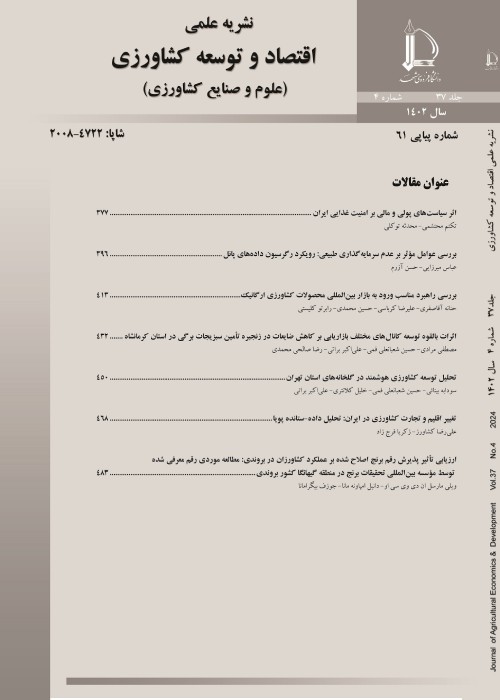Evaluating Uncertainty of Palm Trees Efficiency in Ahvaz County: Application of Robust Data Envelopment Approach and Monte Carlo Simulation
Date is one of the strategic and economic horticultural products in Iran due to its important role in gross domestic product, employment and export. Therefore, investigating the efficiency of date producers and trying to improve their efficiency through optimum use of resources have special importance. Several techniques are used to evaluate efficiency of decision making units (DMUs). Data Envelopment Analysis (DEA) is recognized as a methodology, widely used to evaluate the relative efficiency of a set of DMUs. Although, DEA is a powerful tool for measuring efficiency, there are some restrictions to be considered. One of the important restrictions involves the sensitivity of DEA to uncertainty of the data in analysis. In this research, the linear robust optimization framework of Bertsimas and Sim (2004) was applied in DEA with uncertain data.
Data envelopment analysis (DEA) traditionally assumes that input and output data of different DMUs are measured with precision. However, in many real applications, inputs and outputs are often imprecise. This paper applied a robust data envelopment analysis (RDEA) model using imprecise data represented by uncertain set in estimating the efficiency of date producers. The method is based on the robust optimization approach of Bertsimas and Sim (2004) to seek maximization of efficiency under uncertainty (as does the original DEA model). In this approach, it is possible to alter the degree of conservatism to let decision maker know the trade-off between constraint’s protection and its efficiency. The method incorporates the degree of conservatism in maximum probability bound for constraint violation. 85 date producers were selected by simple random sampling and necessary data were collected by completing a questionnaire.
In this section, the results of evaluating date producers are presented which consists of eight inputs and one output. For denoting input and output data uncertainty, ten given maximums of constraint’s violation probability were considered with respect to nominal values: 10%, 20%,…100% (i.e. we used Γ = 0.10, 0.20,…1.00). The results revealed that Gamma value decreases as the probability of constraint violation increases. The RDEA model result showed how efficiency declines as the level of conservatism of solution increases or as the constraint violation probability decreases. According to the method, if all Gammas equal 0, then robust and original DEA models are the same. The most difference between mean of optimal and actual amount of inputs is related to four inputs including machinery, fertilizer, pesticide, and irrigation water in both DEA and RDEA models. In this regard, the government and other relevant authorities should provide producers with extension services to help them optimize inputs. The average technical efficiency for this category of producers is estimated at 90%, and this result indicates a relatively high level of technical knowledge of farmers in using current technologies. In simulating violation probabilities ranging from 0.1 to 1.0 (at a constant the level of ε), percentages of average conformity are quite high.
Evaluating the performance of many activities by a traditional DEA approach requires precise input and output data. However, input and output data in real-world are often imprecise or vague. To deal with imprecise data, this study used a robust optimization approach as a way to quantify imprecise data in DEA models. It is shown that the Bertsimas and Sim (2004) approach can be a useful tool in DEA models without introducing additional complexity into the problem (we called robust data envelopment analysis (RDEA)). A case study of Ahvaz county date producer is presented to illustrate reliability and flexibility of the model. The problem was solved for a range of given uncertainty and constraint violation probability levels using the GAMS software. This case suggests that our approach identifies the tradeoff between levels of conservatism and efficiency. As a result, efficiency decreases as the constraint violation probability increases. Additionally the RDEA approach provides both a deterministic guarantee about the efficiency level of the model, as well as a probabilistic guarantee that is valid for all symmetric distributions.
- حق عضویت دریافتی صرف حمایت از نشریات عضو و نگهداری، تکمیل و توسعه مگیران میشود.
- پرداخت حق اشتراک و دانلود مقالات اجازه بازنشر آن در سایر رسانههای چاپی و دیجیتال را به کاربر نمیدهد.



